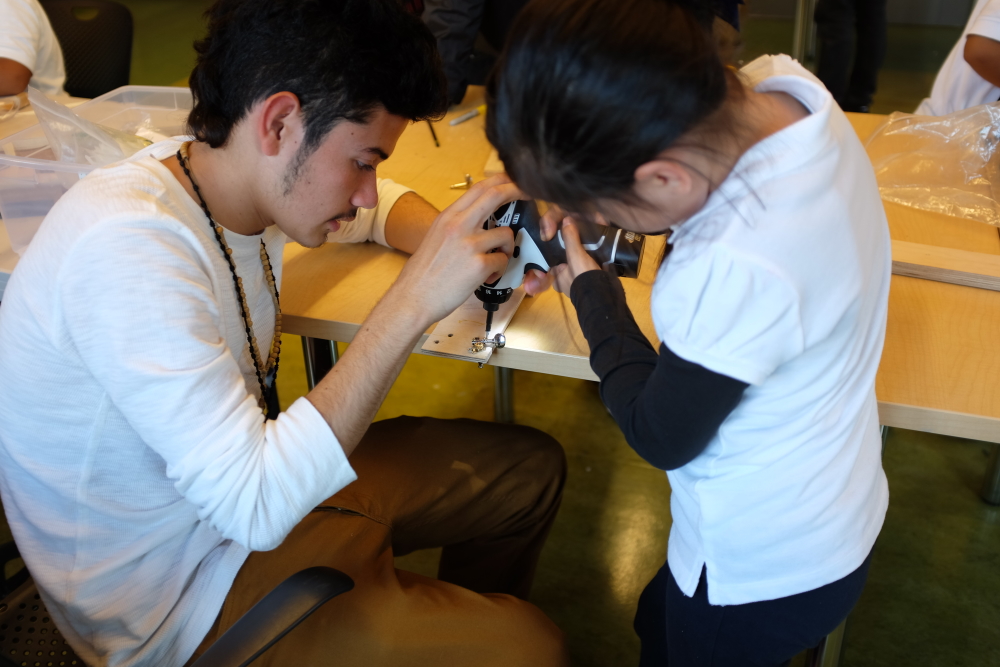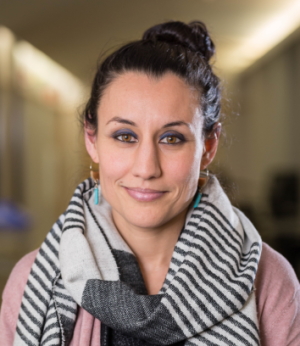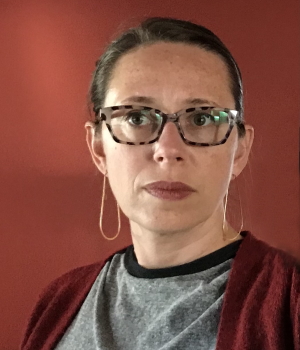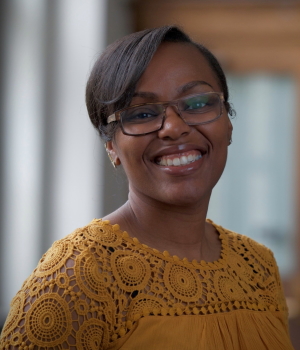
Meg Escudé
A teen mentor works with a child on her project in the Tinkering Afterschool Program.
Throughout our work in youth programs and critical educational spaces, we have witnessed how educators, mentors and facilitators committed to liberatory learning often wrestle with the “pendulum swing” between adult- and child-centered education. Many of us come to youth work to struggle against dehumanizing forms of teaching and the specific ways they work to constrict the minds and spirits of children of color. Yet the pendulum swing can also lead educators to avoid direct teaching for fear of being too didactic or school-like, to the detriment of building just and expansive forms of learning.

Shirin Vossoughi
Consider the common mantra: “I’m not a teacher, I’m just a facilitator.” Though used to signal a divergence from rigid pedagogies, such language risks disparaging rather than reimagining the craft of teaching, and diminishing the labor of youth workers. Hands-off teaching can result in too little structure, leading adults to reassert control or to blame students for a lack of engagement. It can also undercut the kinds of explicit teaching and historicizing needed to challenge whitewashed curriculum and support young people’s sense-making around racism and other forms of injustice.
While many critical educators nurture meaningful relationships, guidance and dialogue, it’s not uncommon for youth-centered spaces to describe their work in ways that downplay the role of pedagogy — leading to missed opportunities for learning across educators. This tendency can echo Western models of parenting and schooling that prize independence over interdependence and collaborative thinking.
Must adults be backgrounded?
Reflecting on these tensions has led us to see that the language we use to describe teaching is often constrained by either/or thinking: lecture versus dialogue, explanation versus hands-on exploration, active engagement versus student listening. These binaries flatten the range and depth of human teaching and learning.
Depending on how it’s organized, classroom dialogue can open up deep connections and understandings, or it can feel like going-through-the-motions of what the teacher wants us to say, or some combination of both. Some lectures are indeed lifeless; but others are deeply moving — like being inside a poem. A focus on pedagogical form rather than quality overlooks the felt experience of learning, and the dynamic ways practices like lecture and dialogue can interweave. It can also set educators up to avoid or underdesign generative forms of assistance and intergenerational collaboration.
Part of the challenge is that the authoritarian nature of assembly-line schooling often leads to treating adult supremacy as the problem that must be continuously resisted through a backgrounding of adults. Yet this tendency risks treating these systems as the sole grounds for imagination. Many educational thinkers have sought to rethink these terms, arguing that the most dynamic learning emerges when both adults and young people are active participants, partners in thinking.
Some direct explanations aren’t negative
Our own history of work and collaboration has focused on co-designing and studying intergenerational learning in the context of making and tinkering spaces. “Making” is a term recently adopted to describe creative activities such as building, sewing, repair, cooking, art, technological invention and music-making. Many educators have taken up making as a rich educational form that has the potential to meld the arts and sciences through meaningful projects.
Yet the “Maker Movement” has also been taken to task for reproducing ethnocentric, patriarchal and neoliberal values, as seen in who is represented as a “maker,” what is considered “making,” and in the entrepreneurial emphasis on using expensive tools to make product prototypes that can be marketed at scale. Building on these critiques, we also raise concerns about the movement’s limited attention to teaching and the social experience of learning.

Meg Escudé
Our research analyzed everyday teaching and learning interactions within the Tinkering Afterschool Program (TAP), an ecology of making/tinkering settings serving elementary and high school-aged youth from Black, Latinx and Asian American communities in the Bay Area. Analyzing hundreds of instances of teaching within TAP, we found that educators often used direct forms of explanation to introduce a tool or mechanism, to make the “why” of particular practices visible (a teacher explaining why she was holding a hammer further back on the handle) or to work with children to interpret the results of a test run.
When working with 7-year-old Shauna, Walter (artist and educator) pointed to the legs of an LED light and said, “These are sort of set apart on purpose because if they touch then you can get a short-circuit.” Shauna replied, “What’s that mean?” Walter explained: “That means any electricity that jumps across this gap. Like if this is bent and touches this one then your light won’t turn on.”
Active listening shows respect
Constructionist models often worry that adult explanations will constrain students’ own thinking, yet waiting too long to share an explanation can also be experienced negatively as withholding. Here explanation helped create an ethos of inquiry and observation, as seen in the thoughtful use of technical terms that invited Shauna’s curiosity.
We noticed that productive explanations emerged in the context of thinking with rather than doing things for children. This nuance is important for addressing a common tension voiced by novice educators in making and other youth-centered spaces: “I saw them struggling but didn’t want to take over.” When we asked children to describe the help they received in TAP, many commented on the ways TAP educators help kids learn how to build and create. Seven-year-old Tania said, “In Tinkering, they tell you a lot about how to do it and then [school] teachers are telling you what you have to do, like write the letter and stuff like that.”
Well-timed explanations that emerge in the flow of collaboration can convey a sense of intellectual respect, meeting children’s desire for growing competence with substantive supports. They can also serve as portals into the wider conceptual universe of activity.
We found that taking the time to notice how students were thinking with their hands and making meaning in the moment often allowed educators to tailor explanations in ways that connected to students’ purposes. From a child-centered perspective, teacher listening is often framed as passive. Yet these observations helped us see listening as an active mode of being and relating that opens up new possibilities for teaching.
TAP educators also frequently shared stories that emphasized the process of making — developing ideas, testing, drafting and revising. Teen staff shared examples of their own projects, describing the inspirations, ah-ha moments and challenges they encountered. Meg (TAP director) often connected these stories to the work of artists, scientists and writers, emphasizing the creative power of attending to feedback from the materials one is working with. Stories of process helped create an ethos of second chances, defining the experience of novelty as a starting point for practice, rather than a marker of incapability. James, a veteran participant and teen mentor, said TAP helped him see the difference between “not knowing” and embracing the role of a learner.
Children see some help as role models
Finally, our research helped us to see the powerful role of embodied assistance: a teacher using her hands and words to offer students the feel of working with a new tool, a student shifting their body so a peer can better observe how they are approaching a task, or educators reminding teen mentors to keep artifacts close to children’s eye level when explaining the workings of a mechanism. Patterns in these kinds of interactions shape how knowledge is shared within a setting, and the ways children come to experience themselves as competent and respected thinkers.

Natalie R. Davis
In working with educators to recognize how the subtle taking over of children’s projects can convey deficit assumptions about their capabilities, we noticed that many initially respond by being more hands off. Over time, however, being reflective and intentional about embodied collaboration can help move beyond the binary of hands-on/hands-off teaching. Tracing students’ trajectories over time within TAP also helped us see how children were experiencing these forms of embodied guidance as ethical models for how they could help their peers.
Rather than assuming a conflict between adult help and student agency, these examples show how receiving help can become a developmentally generative experience of having one’s mind taken seriously. We see such respect as a core aspect of educational dignity, akin to what Miguel Zavala describes as processes of “rehumanization that takes place in and through cognitive work.”
Imagining beyond adult- versus child-centered binaries requires questioning either/or thinking and attuning to the when and how of practices like explanation or storytelling. Meg and Walter are also teaching artists who approach educational design as a process of creating beautiful experiences with and for others.
Such artistic dispositions can help discard the anxieties that undermine pedagogical leadership within child-centered frames and nurture patience with regard to how students engage the ideas and tools being offered. The rush to see particular forms of student voice early within a setting can overlook the ways moving together at a careful pace and trusting the process of shared meaning making nourishes intergenerational relations and signifies a belief in the brilliance of young people.
Shirin Vossoughi is an educator and assistant professor of learning sciences at Northwestern University, where she researches the social, cultural, political and ethical dimensions of human learning. She partners with youth, educators and families to study the conditions that foster educational dignity and possibility.
Meg Escudé is an educator and an artist. She has been committed to fostering creative and liberatory learning in spaces outside schools for the past 15 years and is now a Ph.D. student in education at the University of California, Berkeley.
Natalie R. Davis is an assistant professor of creative and innovative education at Georgia State University. As an educational ethnographer, former elementary school teacher and learning scientist, Natalie’s research focuses on justice-oriented learning environments (e.g. schools, makerspaces, summer programs) and the sociopolitical sensemaking of children from nondominant communities.
This piece was developed from a research article published in collaboration with Ava Jackson, Ruben Echevarria and Arturo Muñoz in the journal Cognition & Instruction.





























